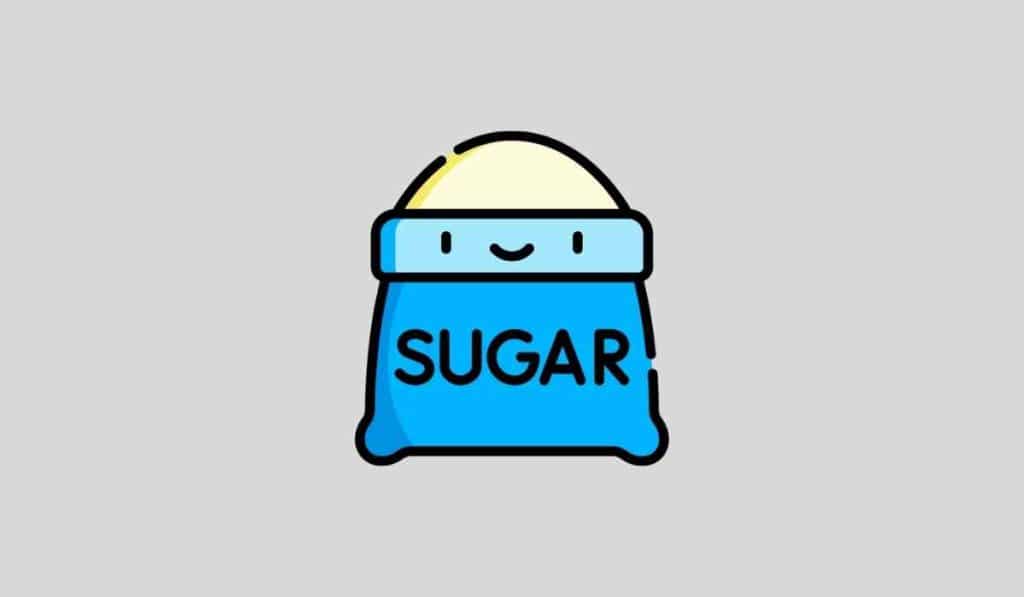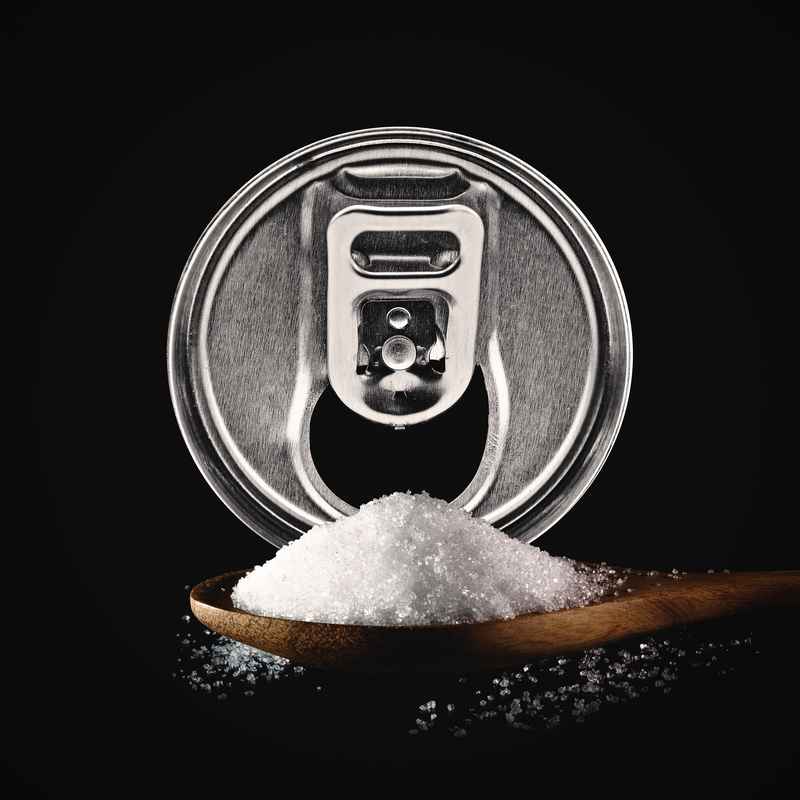Wondering if your sweet tooth is getting you in trouble with keto? Here’s how much sugar you can consume to stay in ketosis and some keto-friendly sweeteners to use as an alternative.

When you think of sugar, you likely have an image of white table sugar in mind.
However, sugar isn’t limited to candies and baked goods!
It’s found in just about any type of processed food these days!
Combine that, with the debate over sugar and alternative sweeteners in relation to the Keto Diet and it’s hard to know what’s what.
Let’s cut to the chase, and talk about how much sugar you can have, along with what you can replace it with in order to satisfy those cravings.
The Ketogenic Diet – Overview and Benefits
“Keto” is short for ketogenic, which refers to the metabolic process of ketogenesis.
It is a low-carb, high-fat, high-protein diet that’s been shown in countless studies for reducing weight1 and decreasing hunger2 , making it a killer diet for burning fat.
Because of how effective it is, it’s exploded in popularity in recent years.
Fun Fact: The ketogenic diet was originally used to treat children with epilepsy in the nineteenth century.
The way it works is by using fat for energy instead of carbohydrates.
The way the diet is set-up is that you restrict carbohydrate intake, reducing glycogen stores, and causing the body to produce and use ketones as an energy source.
This metabolic state is called “nutritional ketosis” and it has a metric TON of benefits:
Weight loss – Not only does it boost metabolism, but the more our bodies get used to using fat as energy, the more efficient they become at doing so over time3.
Appetite control – Fats and proteins are much more satiating and filling than carbs. Not only that, but Keto focuses on consuming more healthy foods that actually offer nutritional value. Moreover, research has suggested that ketogenic diets reduces hunger-stimulating hormones4.
Reduced risk of diabetes – Ketogenesis helps keep insulin secretion low. By consuming foods that are low on the glycemic index, your blood sugar won’t be shooting up to the sky, or come crashing down after.
Helps prevent chronic and degenerative disease – Keto has been known to help prevent conditions like Alzheimer’s, improve heart health, and even reduce risk of certain cancers5.
Pretty good list of benefits!
But this is contingent on doing the diet properly.
And that means ingesting an optimal amount of sugar on a daily basis.
How Many Grams of Sugar is Too Much on Keto?
Reduced sugar consumption is almost never a bad idea, but when you are doing keto, it’s critical.
The goal is to keep your carb intake around 20 to 50 grams per day, or around 5% of your total food intake.
Sugar is a carbohydrate, so any more than that, and you’ll likely get knocked out of ketosis.
It’s difficult to give a blanket number for everyone, as it does vary depending on your size and weight.
However, if you’re thinking of going for straight-up refined sugar, it’s best to avoid it almost completely.
A proven way to accelerate getting into ketosis is using exogenous ketones, otherwise known as keto pills. We did a thorough round-up of the best keto pills in this review.
Sugar causes the glycemic index to soar
The glycemic index refers to how much a food or beverage spikes our blood glucose, and on Keto we want to avoid spiking it at all costs.
When you consume simple sugars, it skyrockets.
So, even if that piece of cake doesn’t take you to 50g of carbs per day, you could still spike your blood sugar.
The most effective way for you to figure out how many carbs (and specifically, sugars) you should consume a day is by testing yourself.
Related: 25 Best Foods to Eat on the Keto Diet
This is done by eating foods consisting of different amounts of carbs and testing your blood to see your blood sugar and ketone levels afterward (most ketone test strips can perform this function).
Your ketone levels will let you know if you’re in ketosis, while your blood glucose levels afterward will tell you about your metabolic health and insulin sensitivity.
Both are very helpful in understanding your body, and how it operates with ketosis.
Net Carbs
Now, let’s add another layer to the mix. There’s a lot of talk around “net carbs” and how it relates to our total carb consumption.
Sugars, starches, and fibers are all considered to be carbohydrates.
Some foods – like bread and pasta – contain a lot of starch and little sugar.
Sweets contain a lot of sugar but little to no starch.
But all of them are carbs.
Now, when we get to fiber, it’s a bit different.
Fiber kind of “counteracts” or “buffers” the amount of sugar and starch consumed (to a certain extent), so you can take fiber out of the equation.
Say your meal contains 10 grams of sugar, starch, and fiber each.

With the sugar and starch together, you have 20 grams of carbs.
Subtract the 10 grams of fiber, though, and you now have 10 grams of net carbs.
Taking that into consideration, you do have a bit more flexibility.
While it’s not recommended to eat 50 grams of just sugar per day, Keto is not a zero-carb diet, either.
If you want a little treat, just make sure it fits into your meal plan.
This is also where meal planning comes in, as it’s a very helpful way to work in treats without compromising your goals.
Most keto meal planners factor treats into their meals (Custom Keto Diet is an excellent example of this), giving you the option of having your (keto-friendly) cake and eating it too.
What Happens When We Consume Too Much Sugar on Keto
So, we know we’re not supposed to consume too much sugar on a Keto diet.
But what happens if we do?
While having a few treats from time-to-time isn’t going to destroy your progress, it will potentially set you back.
Not only that, but there can be some undesirable side effects that you likely don’t want to deal with, including but not limited to:
- Blood sugar will spike, kicking you out of ketosis/ketone production will stop.
- Most sugars you consume will likely replenish glycogen stores, which could cause you to gain water weight (See also: 6 Reasons You Are Not Losing Weight on Keto)
- Gastrointestinal discomfort. This could range from bloating, to nausea and even vomiting. This is because your body is no longer used to digesting high-carb foods like it used to be.
- Increased appetite and cravings after consuming too much sugar isn’t unheard of. This often leads to a vicious cycle of overconsuming sugar.
- If you already had a sugar addiction before Keto, it could be more difficult to get back on track.
- You could experience some keto flu symptoms while getting back into ketosis. Fatigue, muscle cramps, headaches, and digestive issues are common.
- The frustration of falling off the wagon. If you have an “all-or-nothing” kind of mindset, this may affect you more.
As you can see, for many people and in most situations, the momentary sugar rush isn’t worth it.
While the occasional treat shouldn’t derail all of your efforts and long-term weight loss goals, it could cause more issues than you expect.
Keto-Friendly Sweeteners to Substitute for Sugar
Now, let’s talk about the fun stuff!
There are plenty of Keto-friendly sweeteners and sugar substitutes out there that’ll make you forget all about refined sugars.
These tasty alternatives won’t cause negative side effects, and they won’t derail you from what you’re trying to accomplish.
Even if you have a sweet tooth, you’re bound to find enjoyable Keto treats!
Speaking of having a sweet tooth, these sweeteners can actually keep your blood sugar from spiking which can result in more sweet cravings.
It seems like every day there is a new low-carb sweetener out there to try, so these options will only continue to expand!
Meal planning is your best friend when it comes to getting into keto and staying there. Check out this review of the best keto cookbooks for tons of meal planning advice, recipes, and more.
The top Keto sweeteners out there are Stevia, Monk Fruit Sweetener,and Allulose.
All three are natural sweeteners with a low glycemic index.
Stevia is found in many cafés and restaurants nowadays, which is perfect for sprinkling in your coffee while out on the town.
Studies have actually shown that unlike refined sugar, Stevia can lower blood sugar.
Monk Fruit has been used in traditional Chinese medicine for countless years, and is very sweet yet very low in carbs.
However, with monk fruit sweetener, it’s very important to always read the label.
Many brands will add sugar, molasses, and other substances so it lasts longer on the shelf.
Allulose is a bit less well-known than the other two, and is made from figs, jackfruit, wheat, and raisins.
However, it’s super sweet and is very low on the glycemic index.
Taste-wise, it’s one of the closest to sugar, and doesn’t have a weird aftertaste.
It’s the new kid on the block, but is quickly rising in popularity in the Keto world.
Erythritol and Xylitol are also honorable mentions that are also worth trying.
Erythritol is approximately 75% as sweet as table sugar, but with a GI score of zero, it’s perfect for the Keto Diet.
Moreover, it has the added benefit of promoting healthy teeth and gums.
As our bodies can completely absorb it, it won’t cause digestive upset like many other sugar alcohols do.
Xylitol is heavily used in sugar-free candy and can also help reduce gum inflammation and promotes a healthy gut.
The Bottom Line
While the subject of sugar consumption can be a bit confusing at first, it gets much easier with time.
By following these tips and suggestions, you’ll be well on your way to improving your health and reaching your goals.
There are so many great Keto-friendly sweeteners out there, that you’ll be able to indulge without derailing your weight loss plans.
More Keto Guides and Resources
What Should I Eat on the First Day of Keto? Thinking about trying out the keto diet but don’t know how to get started? Here’s your detailed guide on what to eat on the first day of keto.
9 Keto Diet Tips and Tricks for Beginners. Get started with the keto diet the right way with these nine proven tips and tricks for beginners.